Louisa’s House
This structure is referred to as “Louisa’s House” in memory of Louisa, an enslaved woman who was the family matriarch of one of Locust Grove’s largest enslaved family groups.
It has been discovered through archaeological research that some slave dwellings at Locust Grove were likely in this field on the east side of the house. While the main house has twelve rooms for 10-11 family members, slave dwellings would have had a single room, with perhaps a loft above, and would have likely housed a single family. In some cases, multiple families may have shared a cabin.
These dwellings were modestly furnished but would have contained an open fireplace for food preparation and warmth. The enslaved would have tended small plots of land near their cabins to grow vegetables and herbs for their own consumption.
There are currently 3 known locations; at least two were log with one possibly having been framed. As Locust Grove today is only a portion of the original acreage, there are likely more dwellings that we do not have documentation for.
The single-room dwelling would have been used for both living and working, with the loft above reserved for storage or additional sleeping space.
William Croghan first purchased enslaved workers in 1790. This was likely to help with the construction of Locust Grove. They also enslaved laborers to serve in their home in Louisville and help in business ventures.
By 1820, the height of the farm’s prosperity, the Croghans enslaved at least 48 enslaved individuals.
Enslaved families usually lived together in small cabins like this and were given allotments of food and clothing. Some also had their own small garden plots where they could grow various crops as well.
Enslaved children were involved in the industry of the farm. Young boys chopped wood, carried water, fed animals, assisted with kitchen and laundry chores, cleaned, etc. From a young age enslaed children also apprenticed in a skill such as woodworking, shoemaking, cooking, sewing.
In this room, we find simple furniture and the tools for a skilled woodworker and seamstress.
All of Locust Grove’s enslaved workers were freed in 1856 by John Croghan’s will of 1849; some sued (successfully) to be allowed to remain in Louisville
About Louisa
Check back for a full bio on Louisa Brown soon!
